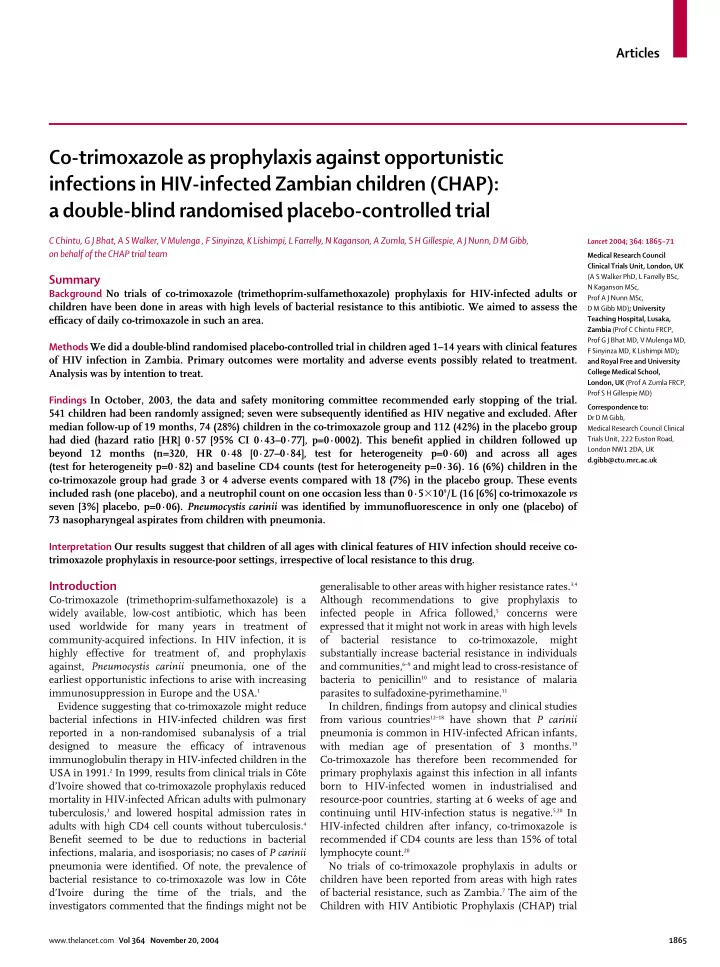

Articles Co-trimoxazole as prophylaxis against opportunistic infections in HIV-infected Zambian children (CHAP): a double-blind randomised placebo-controlled trial C Chintu, G J Bhat, A S Walker, V Mulenga , F Sinyinza, K Lishimpi, L Farrelly, N Kaganson, A Zumla, S H Gillespie, A J Nunn, D M Gibb, Lancet 2004; 364: 1865–71 on behalf of the CHAP trial team Medical Research Council Clinical Trials Unit, London, UK (A S Walker PhD, L Farrelly BSc, Summary N Kaganson MSc, Background No trials of co-trimoxazole (trimethoprim-sulfamethoxazole) prophylaxis for HIV-infected adults or Prof A J Nunn MSc, children have been done in areas with high levels of bacterial resistance to this antibiotic. We aimed to assess the D M Gibb MD) ; University efficacy of daily co-trimoxazole in such an area. Teaching Hospital, Lusaka, Zambia (Prof C Chintu FRCP, Prof G J Bhat MD, V Mulenga MD, Methods We did a double-blind randomised placebo-controlled trial in children aged 1–14 years with clinical features F Sinyinza MD, K Lishimpi MD) ; of HIV infection in Zambia. Primary outcomes were mortality and adverse events possibly related to treatment. and Royal Free and University Analysis was by intention to treat. College Medical School, London, UK (Prof A Zumla FRCP, Prof S H Gillespie MD) Findings In October, 2003, the data and safety monitoring committee recommended early stopping of the trial. Correspondence to: 541 children had been randomly assigned; seven were subsequently identified as HIV negative and excluded. After Dr D M Gibb, median follow-up of 19 months, 74 (28%) children in the co-trimoxazole group and 112 (42%) in the placebo group Medical Research Council Clinical had died (hazard ratio [HR] 0·57 [95% CI 0·43–0·77], p=0·0002). This benefit applied in children followed up Trials Unit, 222 Euston Road, London NW1 2DA, UK beyond 12 months (n=320, HR 0·48 [0·27–0·84], test for heterogeneity p=0·60) and across all ages d.gibb@ctu.mrc.ac.uk (test for heterogeneity p=0·82) and baseline CD4 counts (test for heterogeneity p=0·36). 16 (6%) children in the co-trimoxazole group had grade 3 or 4 adverse events compared with 18 (7%) in the placebo group. These events included rash (one placebo), and a neutrophil count on one occasion less than 0·5 � 10 9 /L (16 [6%] co-trimoxazole vs seven [3%] placebo, p=0·06). Pneumocystis carinii was identified by immunofluorescence in only one (placebo) of 73 nasopharyngeal aspirates from children with pneumonia. Interpretation Our results suggest that children of all ages with clinical features of HIV infection should receive co- trimoxazole prophylaxis in resource-poor settings, irrespective of local resistance to this drug. Introduction generalisable to other areas with higher resistance rates. 3,4 Co-trimoxazole (trimethoprim-sulfamethoxazole) is a Although recommendations to give prophylaxis to infected people in Africa followed, 5 concerns were widely available, low-cost antibiotic, which has been used worldwide for many years in treatment of expressed that it might not work in areas with high levels community-acquired infections. In HIV infection, it is of bacterial resistance to co-trimoxazole, might highly effective for treatment of, and prophylaxis substantially increase bacterial resistance in individuals and communities, 6–9 and might lead to cross-resistance of against, Pneumocystis carinii pneumonia, one of the bacteria to penicillin 10 and to resistance of malaria earliest opportunistic infections to arise with increasing immunosuppression in Europe and the USA. 1 parasites to sulfadoxine-pyrimethamine. 11 Evidence suggesting that co-trimoxazole might reduce In children, findings from autopsy and clinical studies from various countries 12–18 have shown that P carinii bacterial infections in HIV-infected children was first reported in a non-randomised subanalysis of a trial pneumonia is common in HIV-infected African infants, designed to measure the efficacy of intravenous with median age of presentation of 3 months. 19 immunoglobulin therapy in HIV-infected children in the Co-trimoxazole has therefore been recommended for USA in 1991. 2 In 1999, results from clinical trials in Côte primary prophylaxis against this infection in all infants d’Ivoire showed that co-trimoxazole prophylaxis reduced born to HIV-infected women in industrialised and mortality in HIV-infected African adults with pulmonary resource-poor countries, starting at 6 weeks of age and tuberculosis, 3 and lowered hospital admission rates in continuing until HIV-infection status is negative. 5,20 In adults with high CD4 cell counts without tuberculosis. 4 HIV-infected children after infancy, co-trimoxazole is Benefit seemed to be due to reductions in bacterial recommended if CD4 counts are less than 15% of total infections, malaria, and isosporiasis; no cases of P carinii lymphocyte count. 20 pneumonia were identified. Of note, the prevalence of No trials of co-trimoxazole prophylaxis in adults or bacterial resistance to co-trimoxazole was low in Côte children have been reported from areas with high rates of bacterial resistance, such as Zambia. 7 The aim of the d’Ivoire during the time of the trials, and the investigators commented that the findings might not be Children with HIV Antibiotic Prophylaxis (CHAP) trial www.thelancet.com Vol 364 November 20, 2004 1865
Recommend
More recommend